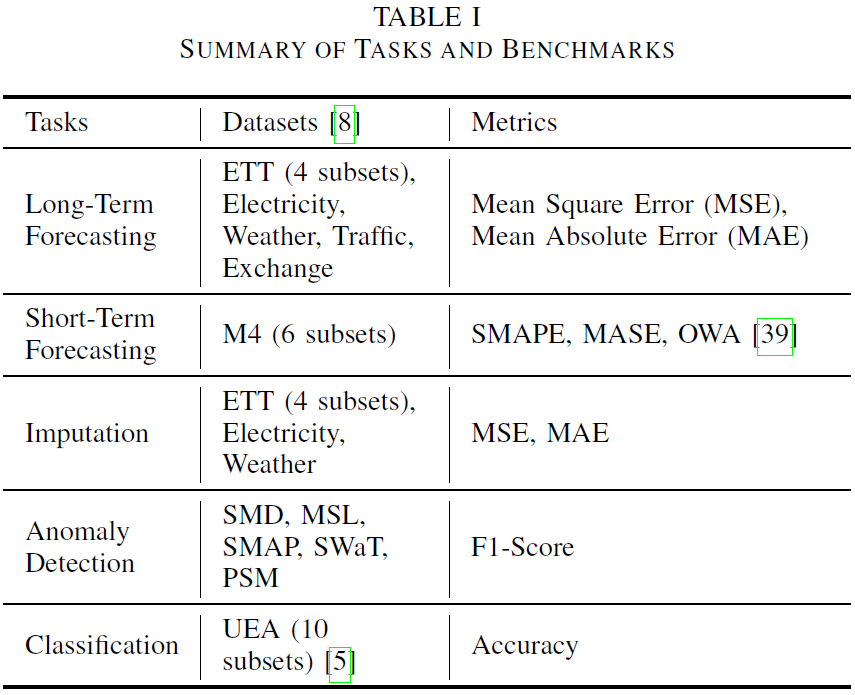This is the PyTorch and Lightning implementation of our VLDB 2024 paper: A Multi-Scale Decomposition MLP-Mixer for Time Series Analysis. (https://arxiv.org/abs/2310.11959)
If you find this repo useful, please consider citing our paper:
@article{10.14778/3654621.3654637,
author = {Zhong, Shuhan and Song, Sizhe and Zhuo, Weipeng and Li, Guanyao and Liu, Yang and Chan, S.-H. Gary},
title = {A Multi-Scale Decomposition MLP-Mixer for Time Series Analysis},
year = {2024},
issue_date = {March 2024},
publisher = {VLDB Endowment},
volume = {17},
number = {7},
issn = {2150-8097},
doi = {10.14778/3654621.3654637},
journal = {Proc. VLDB Endow.},
month = {may},
pages = {1723–1736},
numpages = {14}
}Time series data, including univariate and multivariate ones, are characterized by unique composition and complex multi-scale temporal variations. They often require special consideration of decomposition and multi-scale modeling to analyze. Existing deep learning methods on this best fit to univariate time series only, and have not sufficiently considered sub-series level modeling and decomposition completeness. To address these challenges, we propose MSD-Mixer, a Multi-Scale Decomposition MLP-Mixer, which learns to explicitly decompose the input time series into different components, and represent the components in different layers. To handle the multi-scale temporal patterns and multivariate dependencies, we propose a novel temporal patching approach to model the time series as multi-scale sub-series (i.e., patches), and employ MLPs to capture intra- and inter-patch variations and channel-wise correlations. In addition, we propose a novel loss function to constrain both the magnitude and autocorrelation of the decomposition residual for better decomposition completeness. Through extensive experiments on various real-world datasets for five common time series analysis tasks, we demonstrate that MSD-Mixer consistently and significantly outperforms other state-of-the-art algorithms.
- Create a conda virtual environment
conda create -n msd-mixer python=3.10 conda activate msd-mixer
- Install Python Packages
pip install -r requirements.txt
Please download the datasets from dataset.zip, unzip the content into the dataset folder and structure the directory as follows:
/path/to/MSD-Mixer/dataset/
electricity/
ETT-small/
exchange_rate/
m4/
MSL/
Multivariate_ts/
PSM/
SMAP/
SMD/
SWaT/
traffic/
weather/
Please use python main.py to run the experiments. Please use the -h or --help argument for details.
Example training commands:
- Run all benchmarks
python main.py ltf # equivalent python main.py ltf --dataset all --pred_len all - Run specific benchmarks
python main.py ltf --dataset etth1 etth2 --pred_len 96 192 336
Logs, results, and model checkpoints will be saved in /path/to/MSD-Mixer/logs/ltf
Example training commands:
- Run all benchmarks
python main.py stf # equivalent python main.py stf --dataset all - Run specific benchmarks
python main.py stf --dataset yearly quarterly monthly
Logs, results, and model checkpoints will be saved in /path/to/MSD-Mixer/logs/stf
Example training commands:
- Run all benchmarks
python main.py imp # equivalent python main.py imp --dataset all --mask_rate all - Run specific benchmarks
python main.py imp --dataset ecl ettm1 --mask_rate 0.25 0.5
Logs, results, and model checkpoints will be saved in /path/to/MSD-Mixer/logs/imp
Example training commands:
- Run all benchmarks
python main.py ad # equivalent python main.py ad --dataset all - Run specific benchmarks
python main.py ad --dataset smd msl swat
Logs, results, and model checkpoints will be saved in /path/to/MSD-Mixer/logs/ad
Example training commands:
- Run all benchmarks
python main.py cls # equivalent python main.py cls --dataset all - Run specific benchmarks
python main.py cls --dataset awr scp1 scp2
Logs, results, and model checkpoints will be saved in /path/to/MSD-Mixer/logs/cls
-
For task-general baselines, including
TimesNet,PatchTST,DLinear,LightTS,ETSformer,FEDformer, andNST, as well asN-BEATSandN-HiTSfor short-term forecasting, andAnomaly Transformerfor anomaly detection, we follow and reuse the unified implementations from Time Series Library (TSlib). -
For
Scaleformerfor long-term forecasting, we follow the official implementation from the Scaleformer paper. -
For
TARNet,DTWD,TapNet,MiniRocket, andTSTfor classification, we follow the implementations from the TARNet paper. And forFormerTimefor classification, we follow the implementation from the FormerTime paper
- Time Series Library (TSlib): datasets, experiment settings, and data processing
- UEA Time Series Classification datasets: datasets

